Andrea Baumgartel
baumgart@grinnell.edu
This Friday, two new art exhibitions will officially open in Faulconer Gallery: “Operation Sunshine” by Joan Linder ’92, as well as a selection entitled “Crossing the Line,” of over 50 recent acquisitions to the College’s Art Collection. While one is the work of a single artist and the other is a compilation spanning multiple artists, years and visions, both exhibits are rooted in activism.
“Operation Sunshine” is Linder’s vigilant process of historically uncovering, as well as responding to, the largely buried and forgotten toxic waste sites near Niagara Falls. The Fall’s industrial surroundings included Love Canal, a 36-square-block and formerly residential neighborhood, which was the dumping ground for over 20,000 tons of toxic waste by the then-Hooker Chemical Company (now, ironically, Occidental Petroleum Corporation). The man-made chemical landfill resulted in adverse health and environmental repercussions. Now, the area contains nothing but empty fields behind a chain-link fence.
“They’re so ordinary, nobody really pays attention anymore,” said Faulconer Gallery Director Lesley Wright. “Linder rediscovered these historical documents . . . she saw firsthand the history of people throwing nuclear waste into the Niagara River and performing experiments on people with radiation [in the 1950’s].”
The result of Linder’s meditative examination of the recollected archives was literal re-creation: hand-drawings of around a hundred feet of the very chain-link fence that separates the safe zone from chemical burial grounds; hand-copies of the documents themselves—from printed-out web pages and newspaper clippings to chemical database files—that include every original corner-scribble, highlight, typo, page-crease and other minute details that make the documents real again.
“The act of drawing is an act of paying attention,” Wright said. “By forcing herself to draw every detail, she is paying attention with the hopes that others will.”
Linder employs very few colors, but the ones that are present are cramped, askew yet magnetic. They contribute to a muted realism that is tangible in her brilliant accordion-style folding of the immense fence. The collection is composed of pen-and-ink drawings, some as large as 8 square feet. One piece, which depicts the Love Canal vegetation in Linder’s backyard, shows an infantile meadow of entangled pastels slowly concealing the gravel—suggesting and acknowledging that while life may continue on, history may be buried.
“Crossing the Line” is an exhibit in conjunction with “Rethinking Global Cultures,” a yearlong project sponsored by the Center for the Humanities. The new acquisitions to the Grinnell College Art Collection echo the College’s long tradition of social justice and social activism.
Pieces include a buffalo-hide-bound book of poems honoring and imagining the unwritten words of Sacajawea, political posters, still-flat world maps from the fifteenth century, photographs inside Guantanamo Bay and much, much more.
“Crossing a line in its definition is from going from one place to another,” said Daniel Strong, Associate Director of Faulconer Gallery and Curator of Exhibitions. “But other forms of crossing a line are less benevolent, such as cultural conquests, migrations due to hardship . . . examples that are very much relevant in today’s political climate.”
The pieces are not meant to stand as art alone, but instead to let voices and opinions—that have been traditionally oppressed or ignored—to be heard. The gallery’s collection allows for each message to be communicated in a uniquely sensory way.
“We wanted as many points of view as possible,” Strong said.
The two new exhibits open today at 11 a.m. Admission is always free and open to the public.





































































